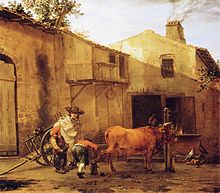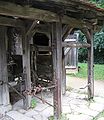Claw stance

A livestock crush or hoof trimming chute ( French travail à ferrer , Spanish potro de herrar ; English hoofstand or cattle crush ) is a construction for fixing and restraint of cattle and workhorses in the hoof and in investigations or veterinary procedures in the standing cattle. In addition, a claw stand is also searched for injuries and inflammations. In addition to the fixation of the animal, such frames also serve to protect people from injuries caused by defensive movements or kicks by the animal.
function
Nowadays, hoof stands are mainly used to fix cattle during claw care, during examinations or during veterinary interventions on standing cattle. The animal is fixed in a position that is favorable for the work to be done and is accessible for examinations and treatments from all four sides. The cattle as well as the handler are protected from injuries caused by defensive movements of the animal. Work on the claws with knives or an angle grinder can be carried out more precisely and safely by fixing the legs. Since the legs no longer have to be fixed and held up by hand, which forces a longer stooped posture, hoof stands enable back-friendly work during hoof care. Tilting stands are used not only for hoof care, but also for surgical interventions on lying cattle.
Historical claw stands
In earlier times the hooves were shod with specially made irons not only on horses but also on draft oxen . In addition, the hooves of the working animals had to be checked regularly for injuries and pebbles. How far back in history the frames constructed for this purpose are unclear. Medieval or even ancient claw stands are neither preserved nor described. The examples shown here all date from the 17th to 19th centuries.
Initially, restless animals were held by several men with the help of long ropes or thrown to the ground during hoof care measures. Serious, sometimes even fatal injuries to those involved were repeatedly caused by being kicked. Quiet animals, on the other hand, could be tied to a wooden post.
The first fixed structures were probably simple wooden posts; they are likely to have been built in the yard of the local blacksmith and on larger cattle farms (possibly also near important cattle markets). In later times in many rural places - partly roofed - devices were built, which consisted of four wooden posts sunk deep into the ground (mainly in France and Germany) or stone pillars (mainly in Spain and Portugal), between which the animals with the help of Ropes and belts could be clamped. The upper connecting bars were used to attach abdominal straps, which made it easier for the animals to stand on three legs for longer periods when lifting or tying the injured or in need of care claws. A sometimes existing fifth stone behind the actual claw stand probably served to lash a rope to stretch the leg.
Because of the amount of rubbish, the roaring of the animals, but mainly because of the possible fire hazard from flying sparks when forging horseshoes , most of the claw stands were on the edge or outside of the respective villages; many of them were covered.
Modern claw stands
Modern hoof stands usually consist of a construction made of metal tubes. There are longitudinal bars on both sides of the stand to prevent the animal from breaking out to the side. In so-called drift stands, the animals can be led into the stand from behind. The animal is then prevented from walking backwards by the closure with a crossbar. At the head of the stand there is a catch gate that can be closed to fix the head of the animal. After completing the treatment, the gate can be opened so that the animal can leave the stand in front.
There are several wide straps between the longitudinal bars, which are stretched under the animal's belly. They can be attracted using a winch, which supports the animal. This means that the body weight no longer has to be completely supported by the legs. The individual legs can be fixed in a raised position on the stand so that the claws are accessible for examinations and care work.
Tiltable claw stands consist of a metal construction to fix the animal with a padded storage table. After the animal has been secured, the entire construction can be tilted by up to 90 ° with a hand-operated winch or one connected to the hydraulics of a tractor, so that the animal lies on its side. All four claws are fixed individually so that they can be treated at a comfortable working height.
Transportable claw stands in the form of a trailer can be transported with the help of a car or a tractor and thus used in different places.
See also
The American behavioral biologist and autistic scientist Temple Grandin constructed a similar but padded construction for herself for reassurance.
literature
- Urs Imhof: The history of shoeing. In: Swiss Archives for Veterinary Medicine. 152, 2010, pp. 21-29. ( Full text PDF; 921 kB)
Web links
- Hoof care in the French national stud
- Claw stands in the French municipality of Anost - Photos + information (French)
- Claw stand in the Spanish municipality of La Cabrera - photo + info (Spanish)
- Claw stand in the Spanish municipality of Horcajuelo de la Sierra - photo + info (Spanish)
- Hoof care on a modern hoof buck - video
Individual evidence
- ↑ M. Zahner, B. Steiner, M. Keck: Looking after suckler cows, securely fixing them, driving and loading. (= Page no longer available , search in web archives: ART report 741 ). Agroscope Research Station, January 2011.
- ↑ C. Lischer (Ed.): Handbook for the care and treatment of claws in cattle. Georg Thieme Verlag, 2000, p. 55f.
- ↑ H.-J. Herrmann: Hoof trimming stands. (= DLG leaflet 362 ). Publisher: DLG e. V. - Specialist Center for Agriculture and Food Industry - Committee for Technology in Animal Production. Frankfurt 2010, p. 5.










